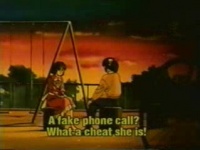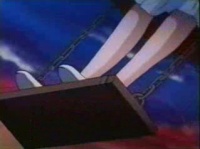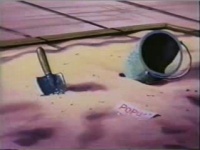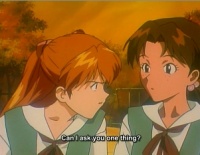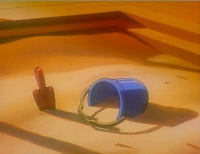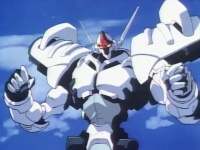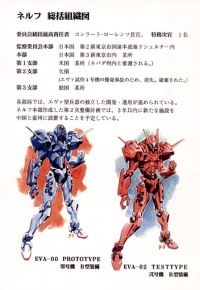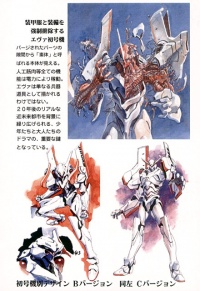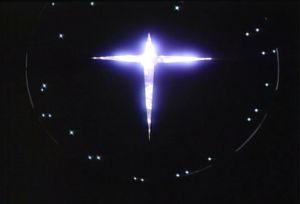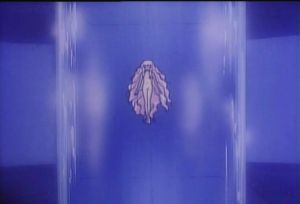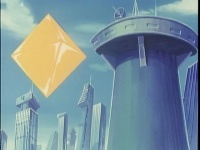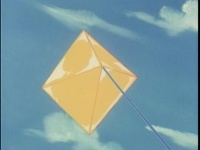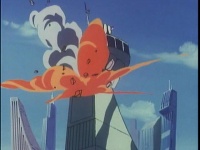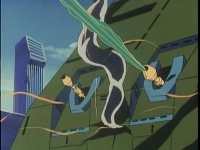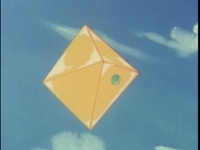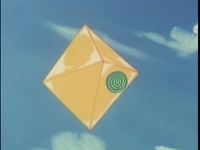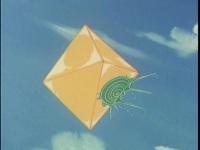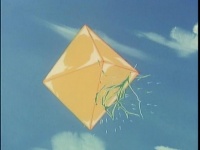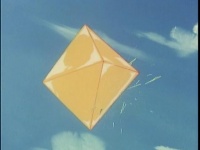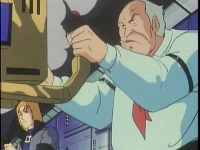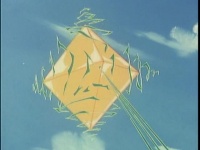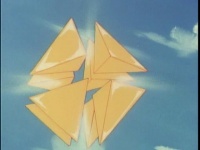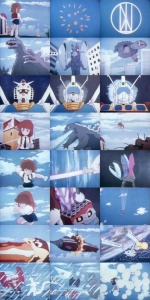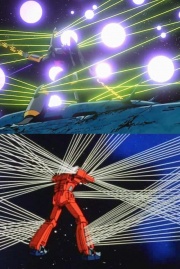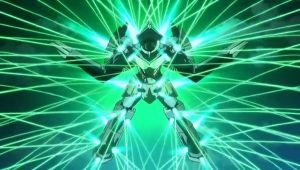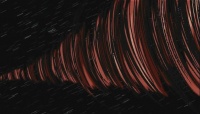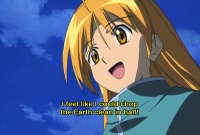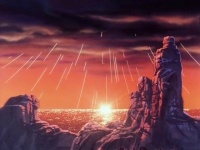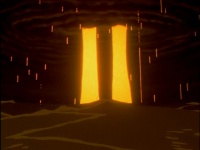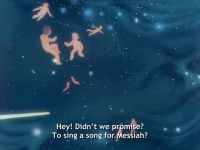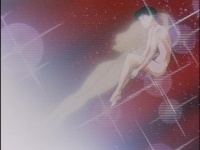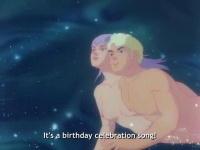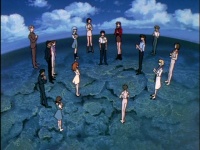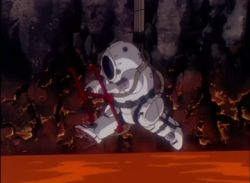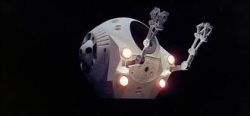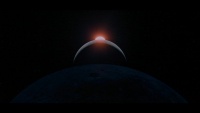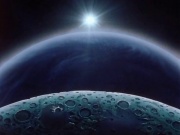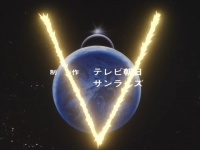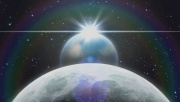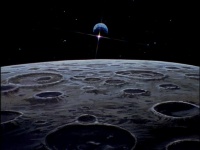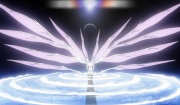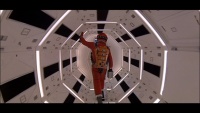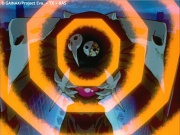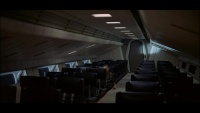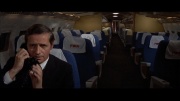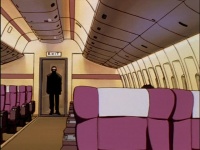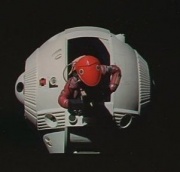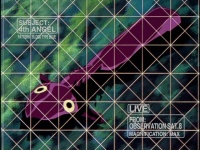tr:Neon Genesis Evangelion'da Diğer Şovlara Övgüler
Başlığın dediği gibi, bu sayfa Evangelion'da bulunan, diğer şovlara referansları veya övgüleri listelemek içindir.
Diğer Animeler ve Mangalar
Brother, Dear Brother (おにいさまへ...)
18. bölümde, Shoujo klasiği Oniisama E namı diğer Brother, Dear Brother'dan bir sahne neredeyse tek tek yeniden oluşturuldu:
- Önce bir parkta iki yakın arkadaşın sohbet ettiğini görürüz.
- Ardından, ayaklarının kalan bir çekimi...
- ...ve ardından bir kova ve kürek içeren yakındaki bir kum havuzunun sahne çekimi vardır.
Oniisama E'nin kadrosunda ayrıca "Rei Asaka" namı diğer "Hana no Saint Juste" (Çiçeklerin Aziz Juste) ve "Kaworu Orihara" namı diğer "Kaworu no Kimi" (Prens Kaworu) adlı karakterler de yer alıyor.
Detonator Orgun (デトネイター・オーガン)
Detonator Orgun, 1991'den kalma üç bölümlü bir OAV'dır. Evangelion'un yaratıcılarını gerçekten etkileyip etkilemediğini kesin olarak söylemek imkansız olsa da, tamamen tesadüfi olsalar bile, fark etmeye değer bir takım benzerlikler var:
Ana karakter Tomoru, duyarlı bir uzaylı bio-meka ile senkronize oluyor; ancak daha sonra "uzaylıların" aslında uzaylı değil, süper gelişmiş insanlar olduğu ortaya çıkar (muhtemelen orijinal Macross'tan etkilenen bir olay örgüsü). Son bölüm, özellikle Orgun'un Grand Cruciform son saldırısı biçiminde, utanmazca abartılı İncil sembolizmi içeriyor. Erken Evangelion tasarımları Orgun'a güçlü bir benzerlik gösteriyor - ancak benzer tasarım özelliklerinin (dev omuzlar ve boynuz benzeri çıkıntılar gibi) 80'lerin sonu/90'ların başı diğer meka animelerinde de mevcut olduğu belirtilmelidir. Daha küçük görsel ayrıntılar, bir tüpte yüzen çıplak bir kız ve birkaç Gendo Pozu içerir.
Devilman (デビルマン)
Go Nagai'nin manga serisi Devilman, benzer bir kıyamet sonu içeriyor. Yoshiyuki Sadamoto, Der Mond Deluxe Edition'da[1] yayınlanan bir röportajda, hem kendisinin hem de Hideaki Anno'nun Go Nagai'den etkilendiklerini ve Devilman'ınkine benzer bir son istediklerini söyledi.
Future Police Urashiman (未来警察ウラシマン)
Future Police Urashiman, 1983'te yayınlanan elli bölümlük bir anime dizisidir. İçinde, Ryuu Urashima, "Urashiman" olarak adlandırılan geleceğe gizemli bir şekilde zaman yolculuğu yapar ve zaman yolculuğunun ona süper güçler verdiğini söyler. Neo-Tokyo'yu güçlü örgüt Necrime'den korumaya kendini adamış Magna Polisi'ne alınır.
47. bölümde, Necrime "Super-X" olarak bilinen yüzen bir oktahedral makineyi serbest bırakır. Sarı yerine Super-X'i mavi yapın ve Ramiel'iniz olsun. Super-X ayrıca bir enerji ışını ateşler ve normal silahlara karşı dayanıklı görünüyor. Daha da ilginç olanı, bugün bile bu gösteriyi malzeme için kullanıyorlar gibi görünüyor. Super-X, Ramiel'in Rebuild'dekine benzer bir şekil değiştirme yeteneğine sahiptir, ancak Super-X orijinal konfigürasyonunda sadece parçalarına ayrılıp yeniden monte edilir.
Laputa: Castle in the Sky (天空の城ラピュタ)
"Laputa: Castle in the Sky", Hayao Mizayaki tarafından yazılan ve yönetilen 1986 animasyon filmidir. Laputa'nın baş düşmanı Muska, tavırlarında, hareketlerinde ve renkli, yuvarlak güneş gözlüklerinde Gendo'ya çarpıcı bir benzerlik taşır. Eva'nın ilk bölümündeki sahneyi yansıtan bir sahnede Muska, Tedis kalesinin komutanı; Sachiel'i yok etmeyi başaramayan üç generalden Gendo'nun devraldığı gibi bir sahnede devralır. Muska ayrıca, Shinji'nin kafesteki Eva Ünite-01 ile ilk karşılaşmasını ve Misato'nun Terminal Dogma'da Lilith'i ilk görüşünü yansıtan bir sahnede, Laputa'nın kahramanı Sheeta'ya bir Robot ("büyük yıkıcı güce sahip mekanik bir asker") gösterir. Robot, açık ve hasarlı uzuvlarıyla Lilith'e biraz benziyor. Bu Robot'a karşı müteakip savaşta, ordunun güçlü bir bomba kullanana kadar ona zarar verme yeteneği çok az veya hiç yok, bu da Evangelion'daki JSSDF'nin bir N2 Madeni kullanana kadar Sachiel'e zarar veremediğini yansıtıyor. Ek olarak, Robot'un birincil saldırısı, Zeruel'e benzer şekilde gözlerinden fırlattığı güçlü bir ışındır. Bu özelliklerden bazıları geniş kapsamlı mecazlar olsa da, bunların tek bir sekanstaki birleşik varlığı ve bu sekansın bir Miyazaki filminde olması, "Laputa"nın Evangelion'un yapımında Anno üzerinde doğrudan bir etkisi olduğu fikrine güven veriyor. (Miyazaki'nin Anno üzerindeki etkisi hakkında daha uzun bir tartışma için, "Nausicaa of the Valley of the Wind" bölümündeki "Anno & Nausicaa"ya bakın).
| Laputa: Castle in the Sky | ||
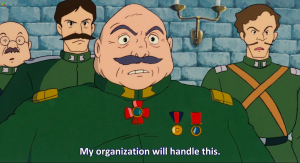 |
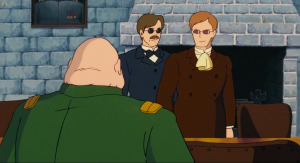 |
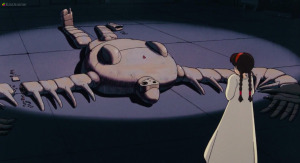 |
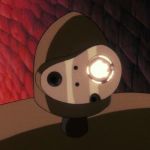 |
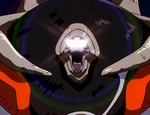 |
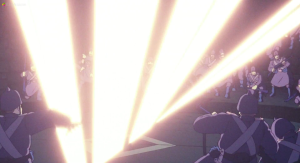 |
My Neighbor Totoro (となりのトトロ)
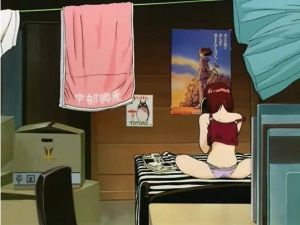
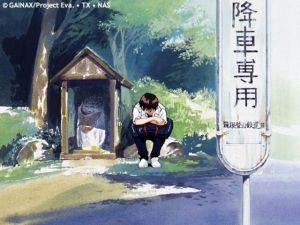
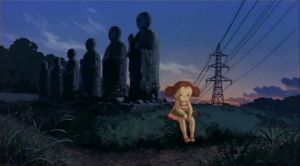
4. bölümde, otobüsten indikten sonra Shinji, gezginlerin ve çocukların koruyucu tanrısı Jizo-san'ın bir heykelinin yanında dinleniyor. Bu kare görünüşe göre Miyazaki'nin "My Neighbor Totoro" filminden benzer bir kareye bir övgüdür. Anno'nun Miyazaki'nin “Nausicaä”sında animatör olarak çalıştığı ve Evangelion'dan önce Ghibli filmlerine göndermeler yaptığı düşünülürse, bu karşılaştırma çok da abartılı görünmüyor.
Nausicaa of the Valley of the Wind (風の谷のナウシカ)
Nausicaa of the Valley of the Wind, Hayao Miyazaki'nin Şubat 1982'den Mart 1994'e kadar Animage dergisinde yayınlanmış ve yedi cilt halinde toplanmış bir mangasıdır. İlk iki cilde dayanan ve Miyazaki tarafından yönetilen bir sinema animesi Mart 1984'te yayınlandı. Manga, Eva'da kullanılan birkaç doğrudan benzerlik içeriyor:
- Prenses Kushina'nın annesi, Asuka'nın annesi Kyoko için ilham kaynağı gibi görünüyor. Kyoko gibi, Kushina'nın annesi de gerçek kızını tanıyamazken bir çocuğun oyuncağının kendi kızı olduğuna inanacak kadar delirmiştir.
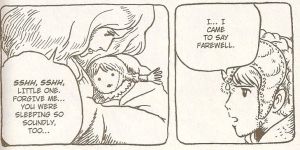
- Ve belki de en keskin benzerliklerden biri, Yedi Gün Ateşinde dünyayı yok eden insan tarafından yaratılan canavarlar olan Tanrı Savaşçılarının, Evangelionların kendilerine ilham verenlerden biri olduğu gerçeğidir. Her ikisi de hem yapay bir iskelet çerçevesine hem de etrafında büyüyen ve ona şeklini veren organik materyale sahip biyomekaniktir. Tanrı Savaşçıları, Evalar gibi, bağımsız düşünce ve eylemde bulunma ve hatta bir ruha sahip olma yeteneğine sahiptirler. Her ikisinin de Nausicaa'daki Tanrı Savaşçısı'nın kendisini insan ırkının hakemi ilan etmesiyle özel bir amaç duygusu var gibi görünüyor. Her ikisi de büyük miktarda enerji kullanabilir ve Tanrı Savaşçısı, EoE'deki Ünite-01'e benzer ışık kanatları bile oluşturabilir. Tanrı Savaşçısı ayrıca AT Alanının öncüsü sayılabilecek bir şeye sahiptir: Yupa tarafından "bükülme alanı" olarak tanımlanan uçtuğunda ortaya çıkan bir etki.
| Tanrı Savaşçıları ve Evalar | |
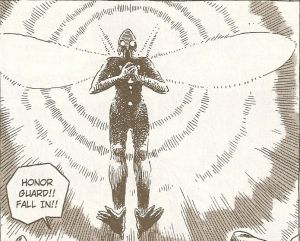 |
 |
Film
Sinema animesi, bazı orijinal unsurlarla birlikte kabaca manganın ilk iki cildine dayanan hikaye ile 4 Mart 1984'te piyasaya sürüldü. Filmde bize yeni bir şey veren hiçbir şey olmasa da, dikkatimizi çeken filmin yapımıdır çünkü Nausicaa, Hideki Anno'nun animasyona başladığı animelerden biri. Filmin Kuzey Amerika DVD sürümünde yer alan “Ghibli Stüdyosu'nun Doğum Hikayesi” tanıtımına göre; 1983 sonlarında, Miyazaki'nin zorlu standartları nedeniyle filmin prodüksiyonu programın gerisine düşüyordu. Arayı kapatmak için "Animage" dergisine, daha fazla animatör kazanmak için bir ilan verildi. Anno, ilana cevap vermek için Tokyo'ya seyahat etti, animasyon stüdyosuna gitti, Miyazaki'nin kapısını çaldı ve Miyazaki'ye kendi yaptığı hikaye tahtalarını verdi. İşinden etkilenen Miyazaki, Anno'ya Tanrı Savaşçısı'nı canlandırma işini verdi. Ghibli Stüdyosu'nun yapımcısı Toshio Suzuki, Miyazaki'nin filmin doruk noktasındaki Tanrı Savaşçısı sahnesini filmin kilit sahnelerinden biri olarak gördüğünü belirtiyor ve seyirciye daha önce hiç görmedikleri bir şeyi göstermek için canlandırmanın son derece zor olacağını ekliyor. Suzuki, Miyazaki'nin "etkili bir şey istediğini" söylemeye devam ediyor. "Eşsiz bir hareket hissi ile çok detaylı.” Anno'nun Tanrı Savaşçısı'nı canlandırma şekli, tankların hareketi ve filmde görülen devasa patlamalar, Miyazaki dahil birçok kişiyi etkiledi.
Anno & Nausicaa
Nausicaa'dan bu yana filmin ve Miyazaki'nin diğer çalışmalarının Anno'yu yönetmeye başladığı andan itibaren etkilediği açıktır. (Daha fazla bilgi için My Neighbor Totoro ve Görsel Motif: Mavi Oktahedronlar (Nadia, Laputa ve 2001) hakkındaki makalelere bakın.) Ghibli Ippai Astar Notları'nda yazdığı bir makaleye göre; Anno, Miyazaki ile geçirdiği zamandan bu yana, Ghibli Stüdyosu'nun sonraki çalışmalarını, herkesin içinden akan “kana” sahip olmadıklarını söyleyerek eleştirdiği biliniyor. Hatta Evangelion Kaibunsho'da Miyazaki ve Anno'nun aslında birbirlerinden nefret ettiğine dair iddialar bile var, ancak bu yalanlandı. Yine de; Anno'nun yukarıda bahsedilen aynı denemede, Miyazaki'yi Ichirou Itano ile birlikte hocaları olarak gördüğünü, sadece animasyonun teknik yönleri konusunda değil, aynı zamanda nasıl film yapımcısı olunacağı konusunda da öğretmenleri olarak gördüğünü belirtmek önemlidir. Anno, "film yapımı konusundaki duruşum, ikisinden öğrendiğim şeylere tutunma girişiminden başka bir şey değil" diyor. Bu yüzden, ikisi arasında film yapımı konusunda muhtemelen bazı felsefi anlaşmazlıklar olsa da, Nausicaa üzerinde çalışmanın daha sonra yönetmen olarak onu etkilediği açıktır.
Space Runaway Ideon (伝説巨神イデオン)
"Space Runaway Ideon", Yoshiyuki Tomino'nun ("Mobile Suit Gundam" şöhretinden sonra) 1980'de yapılmış bir süper robot animesidir ve belki de Evangelion üzerindeki en büyük etkilere sahip tek animedir. Hikayesi, Solo gezegeninde gizemli bir birleştirme robotu olan Ideon'u bulan bir grup sömürgeciyi içeriyor. Kalıntıyı araştırırken, başka bir insansı uzaylı ırkı olan Buff Klanı, onlarla temasa geçer ve bir savaş patlak verir. Kahramanlar, eski bir uzay gemisiyle gezegenden kaçarlar ve Ideon'un muazzam gücünü kullanarak amansız bir şekilde peşlerinde olan Buff Clan'la savaşmak için galaksiyi geçerler. Hikaye ilerledikçe, karakterler robotun kendine ait bir zihni varmış gibi göründüğünü ve evrendeki en güçlü silaha sahip olmanın ilk bakışta göründüğü kadar harika bir şey olmadığını keşfederler.
Ideon'un tamamı Shin Getter Fansubs tarafından hayran çevirisi olarak çevirildi; yaşı ve göreceli belirsizliği nedeniyle, seri kesinlikle batıda ticari olarak bulunamayacak.
- Gainax'ın Diğer Eserlerinde Ideon Referansları
Evangelion'daki Ideon referansları özellikle önemli olsa da, Evangelion, Gainax Stüdyosu'nun ona övgüde bulunan ilk gösterisi değil: Evangelion'dan önce ve sonra yapılan ve beğenilen çalışmalarının çoğu, aşağıdaki listede gösterildiği gibi, Ideon'a az ya da çok ince referanslar içeriyor. :
- Daicon III açılış animasyonu (1981): Bu halüsinojenik kısa filmde küçük bir kız (daha sonra Daicon tavşan kızı olacak) Ideon'un "Füze Spam" saldırısını kullanır ve birçok şeyi (Ideon dahil) havaya uçurur. Evet, o kadar dağınık.
- Gunbuster (1988): 5. bölümdeki iklimsel uzay savaşı sahnesinde, itibari meka, Ideon'un ünlü çok yönlü füze spam saldırısını gerçekleştirir.
- Magical Shopping Arcade Abenobashi (2002): Ideon, Abenobashi'nin "Hook Up! Magical Shopping Arcade Abenobashi"nin 3. bölümünde oldukça fazla referansa sahiptir.
- Diebuster, aka Gunbuster 2 (2004): Ideon'dan daha fazla saldırı referansı. Bir planetoid yarıya bölünür (pek çok ince olmayan öngörüden sonra) ve bir Yıldırım Tekmesi saldırısı, Ideon Gun'a çok benzer bir kasırga benzeri etki üretir.
- Mahoromatic (2001): Mahoromatic'teki bazı savaş androidleri, Ideon Swords'a benzer şekilde, ellerinden uzanan enerji bıçakları şeklinde güçlü bir silaha sahiptir. 25. bölümde Feldrance, özellikle kendini beğenmiş hissederek, bıçaklarıyla Dünya'yı ikiye bölebileceğini hissettiğini söylüyor. Şaşırtıcı olmayan bir şekilde, bir gezegeni ikiye bölmek, Ideon'un en unutulmaz başarılarından biridir.
- Tengen Toppa Gurren Lagann (2007): 14. bölümde, Gurren-Lagann çok ideolojik bir tarzda bir sürü matkap füzesi ateşler.
- Evangelion'daki Ideon referansları: Meka Tasarımı
Ideon yüzeysel olarak klasik bir birleştirici süper robot olmasına rağmen, Evangelion ile benzerlikler daha sonraki bölümlerde ortaya çıkıyor. Ideon, Ide olarak bilinen duyarlı bir enerji tarafından desteklenmektedir. Daha sonra gücünün sınırsız olduğu ve potansiyel olarak evreni yok edebileceği ortaya çıkar. Evangelion'da S² motorları benzer şekilde sınırsız enerji kaynaklarıdır.
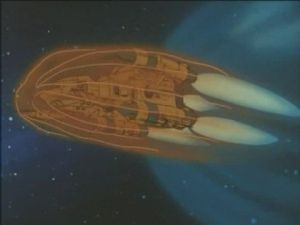
Ide; Ideon ve Solo Gemideki insanların duygularını algılar ve çoğu zaman onları korumak için hareket eder. Gençlere daha güçlü tepki verir, özellikle bebek Piper Lou tehlikedeyken aktif hale gelir - Evangelion'daki pilot senkronizasyona benzer bir kavram. Ide "uyandığında", saldırı ve savunma gücü büyük ölçüde artar ve süper silahları kullanılabilir hale gelir. Aşırı durumlarda, Ideon çılgına dönebilir ve yıkıcı sonuçlarla tamamen bağımsız hareket edebilir. Hem Ideon hem de Solo Gemi, gücü Ide'nin "ruh haline" bağlı olan koruyucu bir enerji bariyeri de yansıtabilir: yine Evangelion, bu özelliği AT Alanı biçiminde geri dönüştürdü.
Ide'nin uyandığını gösteren görsel ipucu, Ide göstergesinin yanması ve Ideon'un "göz vizörü" boyunca akan elektrik çizgileridir. Evangelion'da, Eva'nın yerleşik ruhunun devraldığını gösteren benzer bir etki, düşen bir su damlası ve ardından Eva'nın gözlerinin parlamasıdır.
[[Image:Ideon awakening.jpg|thumb|left|Ideon uyanıyor]
- Ideon'da Tamamlanma
Ide'nin gerçek doğası, Solo Geminin revirinde hasta yatarken bir rüyada duygusal enerjinin Bes Jordan ile temasa geçtiği 34. bölümde somut terimlerle açıklanmaktadır. Ide kendisini "binlerce, on binlerce, yüz milyonlarca bilinçten oluşan bir koleksiyon" olarak tanımlar; sözde soyu tükenmiş bir uygarlığın tüm nüfusu, Evangelion'daki Tamamlanma'nın nihai sonucuna çok benzeyen bir saf enerjiden oluşan tek bir varlığa dönüştü.
Ideon'un çılgınca davranışı, basitçe, kendini ve saf olarak nitelendirdiği kişileri koruyan Ide'dir. Hem insanların hem de Buff Klanı'nın savaşçı doğasına tanık olduktan sonra, şimdi her iki ırkı da yargılamayı planlıyor. Rüya dizisinin sonunda Bes, Ide'ye planlarına karşı çıkacağını söyleyerek, "Ben senin bir parçan değilim! Ben benim, ben kendimim!" der; bu, Evangelion'da Shinji'nin Tamamlanma'yı reddetmeyi ve bireyselliğini yeniden onaylamayı seçtiği ana paraleldir.
- Dini Referanslar
Space Runaway Ideon, Evangelion'daki kadar abartılı olmasa da, dine bazı göndermeler de içeriyor. Buff Klanı'nın Ide hakkındaki bilgisi eski, çarpıtılmış efsanelere dayanmaktadır, bu yüzden itibari robota "Dev Tanrı" olarak atıfta bulunurlar. Nedenleri ortaya çıkmaya başladığında, karakterler kendilerini Ide'nin gerçekten bir tanrı mı yoksa daha kötü niyetli bir şey mi olduğunu sorgularken bulurlar. Karala'nın Ide ile en güçlü bağı olduğu anlaşılan bebeğinin adı Mesih'tir ve ismine sadık kalarak gösterinin sonunda ölülerin ruhlarını yeni bir başlangıca doğru yönlendiren Mesih'tir.
- Üretim Farklılıkları ve Tomino Sonları
Evangelion'un uzun süren başarısızlıklarla gerçekleşen üretim geçmişi, Ideon'unkiyle neredeyse korkutucu derecede paraleldir. Orijinal TV yayını sırasında, Ideon düşük reytingler elde etti ve 39 bölümden sonra iptal edildi, bu da inanılmaz derecede aceleye getirilmiş, belirsiz bir hack-job (bir işin en kısa sürede tamamlanmaya çalışılması) sonuyla sonuçlandı. Ancak yoğun istek üzerine filmin sonu daha sonra iki film olarak yeniden çekildi. İlk film, “A Contact”, 1-38 TV bölümlerinin oldukça yoğun bir şekilde yeniden anlatılmasıydı; ikincisi, “Be Invoked”, 39. bölümdeki olayların bir özetiyle başladı ve ardından insanlar ve Buff Klanı arasında başlangıçta planlanan son çatışmayla devam etti ve hikayeye uygun bir son verdi.
Ideon'un acımasız sonu, anime fandomu için sır olmayan, en büyük sırlarından biridir, çünkü şovu hiç görmemiş olan çoğu anime hayranı, içinde herkesin öldüğünü bilir (ancak, yaygın inanışın aksine, Ideon aslında evrenin kendisini yok etmez). Yoshiyuki Tomino, karakterlerini toplu halde öldürme konusunda her zaman bir tutkuya sahip olmuştur ve Ideon belki de onun en ünlü "kasaplık" eseridir. The End of Evangelion'daki şiddet, Tomino'nun "hepsini öldür" tarzına çok şey borçludur; daha fazla gözden kaçan bir benzerlik ise, The End of Evangelion'daki kadar yaygın olarak kullanılmasa da "Be Invoked'ın" animede canlı aksiyon görüntülerinin kullanımına öncülük etmiş olmasıdır.
Evangelion'un TV finali de Ideon'a önemli bir gönderme içeriyor. Sondaki "Tebrikler!" sahnesi, tüm karakterlerin ruhlarının uzayda uçtuğu ve çocukların onları zımni bir yeniden doğuşa götüren Mesih'e "Mutlu Yıllar Sana" şarkısını söylemeye başladığı "Be Invoked'ın" sonuna benzerdir.
The Super Dimension Fortress Macross (超時空要塞マクロス)
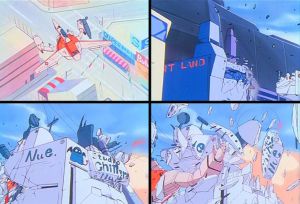
The Super Dimension Fortress Macross is a classic mecha anime that aired on October 3rd, 1982, and started a franchise of TV Series, OVAs, and Movies. It was directed by Noboru Ishiguro and featured unique mech designs that were based on the Grumman F-14 Tomcat. Hideaki Anno was a key animator on this project (as also pointed out in Otaku no Video).[2]
In the first episode, the protagonist Hikaru Ichijo inadvertently ends up piloting and crash-landing a variable fighter, destroying in the process the offices of Artland and Studio Nue, the companies that created Macross. In Episode 09 of Evangelion, Asuka's Eva-02 leaps on and demolishes the half-submerged building of Studio Fantasia, one of the animation studios involved in the production of NGE.
- The human-Zentradi genetic similarity and Protoculture
The story of SDF Macross starts when an interstellar war erupts between humanity and the Zentradi, a space-faring race of warrior giants. While at first there seems to be very little in common with the two races, it is eventually revealed that both are genetically amazingly similar. In a final bombshell revelation it is found out that both the humans and the Zentradi were created in the distant past by an older race of humanoid aliens known as Protoculture: the Zentradi were created for war, humans for preserving culture.
This plot point is mirrored in Evangelion: humans and Angels differ in form, abilities and "matter composition", but are genetically fundamentally similar. While the common cosmic origin of the two races is only hinted at in the show itself, it is stated flat-out in the Classified Information files found within the video game Neon Genesis Evangelion 2. In the files the progenitor aliens are referred to as the First Ancestral Race.
Visual Motif: Blue Octahedrons (Nadia, Laputa and 2001)
The Fifth Angel Ramiel is shaped like a gigantic blue crystal octahedron. This shape could be a reference to a number of things:
- The Blue Water Crystal from Nadia: The Secret of Blue Water is a blue octahedron, although more elongated in shape than Ramiel.
- Hayao Miyazaki's 1986 movie Laputa: Castle in the Sky features a flying castle, which is powered by a similarly shaped blue crystal.
- Also, the "Star Gate" sequence in the movie 2001: A Space Odyssey features different kinds of psychedelic shapes and forms, including pulsating objects which momentarily look very Ramiel-like.
However, since an octahedron is not a terribly complex geometric shape, it is just as likely that all these similarities are simply unintentional coincidences. For all we know, the inspiration for Ramiel's design might have just as well come from a common salt crystal.
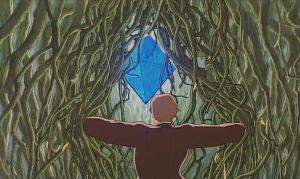

Cho Denji Robo Combattler V(超電磁ロボ コンバトラーV)
A 54 episode TV series directed by Tadao Nagahama, and in a talk between Rahxephon's Yutaka Izubuchi and Hideaki Anno[3], they say that the introduction to Evangelion Unit-01 in Episode 1 was taken from one of the scenes from the beginning of Combattler V. Where all the pilots have been gathered (while the big bad guy is outside laying waste to the city), put into a dark room, then the lights come on revealing the big robot at face level.
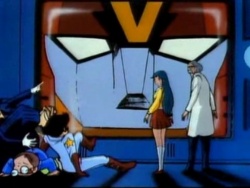
Other Media
2001: A Space Odyssey
- The Monoliths
Perhaps the most well-known science fiction tribute in the series, Seele's black monoliths are taken from Stanley Kubrick's classic 1968 film, 2001: A Space Odyssey.
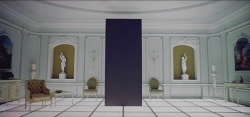
In the 2001 novels, the monoliths were actually built by a race of beings who had transferred their consciousnesses to machines, and who later went further and transferred their consciousnesses to non-corporeal form.
Beyond this one notable reference things get highly speculative. The following visual details have been postulated to be 2001 homages by some fans, and they are included here for completeness' sake. (See also the blue octahedron motif above.)
In episode 10, in order to withstand the extreme environment of a volcano, Unit-02 is geared with D-Type Equipment, which bears a strong visual resemblance to the pods in 2001. These vehicles were called "Extravehicular Activity Pods" or EVA pods for short, and were used by the pilots to operate within the extreme environment of space.
- The Sun, Earth and Moon in alignment
A shot that seemingly originates from 2001: A Space Odyssey and is used again in "spiritual predecessor" Ideon and once again in Evangelion, and in many other unrelated shows. However, this might as well be a case of a simple genre trope, since numerous mecha anime feature shots of the Earth from space, usually in their openings.
In Evangelion, Second Impact is prominently seen from the moon. Also, in a reversal of positions, the Sun is shown with the crescent moon under it, and Earth below, during Third Impact.
- Theme of Evolution
Both 2001 and Evangelion offer ideas surrounding evolution and the advancement of the human species. In 2001, the mysterious monoliths appear at the dawn of man, and later invites man to Jupiter for the next stage in evolution, the Starchild. Their role can be compared to Evangelion's First Ancestral Race and the Secret Dead Sea Scrolls, which guides Seele toward their goal of Human Instrumentality, the next stage in human evolution.
- Concentric Octagons
Aboard the spacecraft Discovery Dave Bowman walks down an octagonal corridor on his way to the Space Pods during the EVA to replace the malfunctioning AE-35 unit. The concentric octagons of an A.T. Field may have been modeled after the corridors on the Discovery.
- Lone Passenger on a Flight
Both in 2001: A Space Odyssey and in The Andromeda Strain, an important scientist is the sole passenger on a flight. Gendo is essentially the only passenger on the SSTO seen in Episode 07
- Dave's helmet and Shamshel
As a somewhat bizarre ending note, it has been pointed out that the helmet of Dave Bowman's space suit bears some resemblance to Shamshel's head.
A Wind in the Door
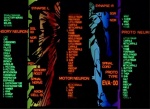
Right before the activation test for Evangelion Unit-00, we see a monitor of Eva-00 with a listing of its synapses and neurons scrolling as text. Under Mitochondria, we see Farandolae. This is a fictional term from Madeleine L'Engle's book, A Wind in the Door, the sequel to A Wrinkle in Time, and are entities which live within Mitochondria. These Farandolae (singular: Farandola) keep Mitochondria alive and, if they were to die, the Mitochondria dies, ultimately resulting in death of the organism[4].
Godzilla
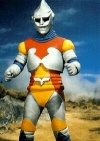
Jet Alone was named after Jet Jaguar, Godzilla's robot ally from Godzilla vs. Megalon. In an early draft of the Megalon script, Jet Jaguar was named Red Alone and Jet Jaguar was made from submissions from the public which he was set to star in a film vehicle for him titled "Jet Jaguar: Fighter of the Planet" which pitted him against Megalon (a previously unused Godzilla monster design at the time) before Godzilla and Gigan where added due to marquee value. The Gainax staff took the first half of the final name and the second half of the preliminary name to make the name Jet Alone. Jet Alone also has a grill on its head that is meant to resemble Jet Jaguar's mouth. [Source needed]
In Evangelion 2.0: You Can (Not) Advance, Misato's ringtone is in fact the roar of King Ghidorah, a three-headed space dragon that has been a prolific opponent of Godzilla since its appearance in 1964's Ghidorah: The Three Headed Monster.
Eventually there would be a offical crossover between Godzila and Neon Genesis Evangelion as the Universsal Studios ride Godzilla vs Evangelion
Space: 1999
The date September 13th is a reference to this 1975 science fiction show by Gerry Anderson. For more details, see Otaku no Video (the first Gainax show to make this reference).
The Andromeda Strain
(This list details some of the more notable references to Wise's 1971 movie version[5] of The Andromeda Strain. As the movie is a very loyal adaptation of Crichton's original novel, the thematic and plotline similarities between the book and Evangelion Episode 13 are largely present in it as well and are not repeated here. Non-visual similarities in plot and a brief overview of the "Messenger Theory" can be found in Theory and Analysis:Episode 13 Similarities to The Andromeda Strain. Most of these findings originate from the Evangelion Mailing List FAQ (although they never had screenshots), so once solid referencing guidelines are in place, we must give credit where credit is due.)
In 1998, Avery Davies pointed out the similarity of these two scenes:
- Interrupted call
Dr. Stone has been hauled away from his home by some "army types with guns". His wife Allison is distressed and tries to call her father who is a senator.
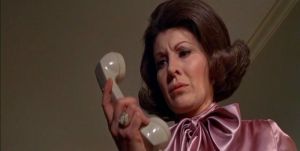
- Allison: You tell the senator it's his daughter!
- Senator: Allison?
- Allison: Dad, something very peculiar has just happened, even for Jeremy. A few minutes ago...
- (Phone begins to beep.)
- Allison: Dad, are you there? What's going on?
- Female voice: This communication is being monitored. The connection has been broken for reasons of national security. You will be briefed at the appropriate time. Thank you for your cooperation, Mrs. Stone.
In Episode 19 (Platinum subtitles):
- Kensuke: Are you there, Shinji? Is it true that you're leaving? It's true, isn't it? But why? Why are you running away now? I wanted to be like you. I envied you. You're different from us. Damn! Even Toji became an Eva pilot, while I...
- (Phone beeps.)
- Female voice: This line is monitored. For security reasons, we have terminated this call. We appreciate your cooperation.
- Flashes in the sky
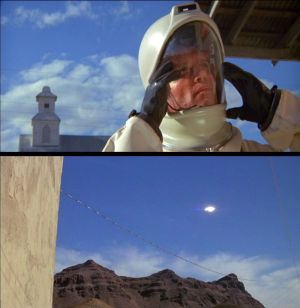
- Hall: Up there! Look.
- Stone: An Air Force jet. If we don't make it to Wildfire, he'll see the helicopter does... or shoot it down.
- Hall: Well, for Dempsey's sake, we better not slip up.
In Episode 10 (Platinum subtitles):
- Shinji: What are those?
- Ritsuko: The UN's Air Force is on standby alert.
- Ibuki: Until this mission has been completed.
- Asuka: Are they going to help us?
- Ritsuko: No, they're here to clean up.
- Ibuki: In case we fail.
- Asuka: What do you mean?
- Ritsuko: They will use N2 depth charges to destroy the Angel, and us with it.
- Asuka: That's awful!
- Open transmission
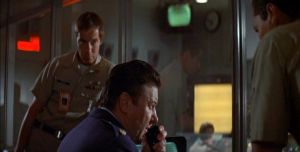
- Stone: The town is finished, contaminated beyond all...
- Major Manchek: Careful, sir. This is an open transmission.
- Stone: I'm aware of that, Manchek. Order up a 7-12.
- Major Manchek: Only the president...
- Stone: Precisely. Get on it. The town must be neutralized immediately.
In Episode 10 (Platinum subtitles):
- Misato: There's no doubt, it's an Angel. As of now, this laboratory will be completely sealed off! It's under Nerv's jurisdiction now! Any and all access to the outside world is prohibited, and all records of the events of the past six hours are classified. Request an A-17 from Commander Ikari, top priority!
- Aoba: Watch what you're saying. This is an open line.
- Misato: I know. Hurry up and switch to a scrambled line.
- Code 601
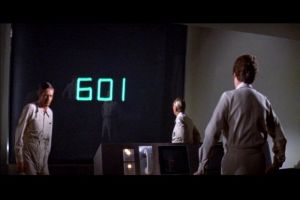
During a simulation of how the Andromeda Cell functions, an error message appears on the main computer monitor.
- Dutton: What the devil?
- Stone: 601? The computer's overloaded! Too much data coming in too fast.
In Episode 05 (Platinum subtitles):
- Misato: What the heck is this?
- Ritsuko: That's the code number for "cannot be analyzed".
- Misato: You mean, you don't know what the heck it is?
- The Shaft
Both the Wildfire facility and the Geofront have a large shaft running deep below and past several levels, and the visual displays for both are very similar.
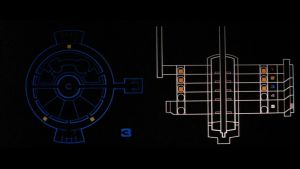
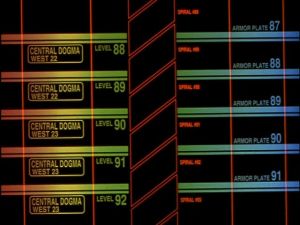
In addition to the Geofront-Wildfire similarities, the wildfire visual display appears to influence the Entry Plug Visuals in Evangelion 2.0.
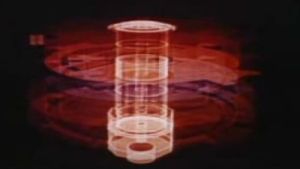
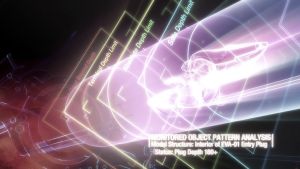
- Hexagons
As opposed to the usual octagonal, Ireul's A.T. Field projections are hexagonal in shape. Andromeda Cells, although constantly evolving, most often assume a form of a lattice of hexagonal crystals.
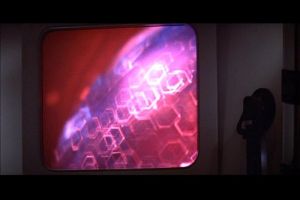
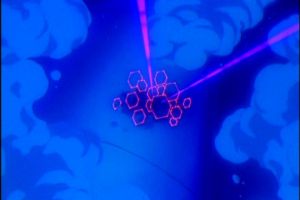
Furthermore, the walls of Lilith's Black Moon, visible when Ritsuko, Misato and Shinji ride down to Terminal Dogma via elevator in Episode 23 are in a hexagonal grid pattern, with visible notches, whorls and other irregularities that strongly resemble the electron-density mapping images of the Andromeda organism depicted in the novel.
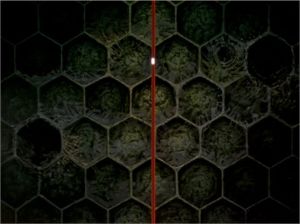
- Time placards
The placards in Episode 20 use the same method of counting time (black background with Nth DAY).
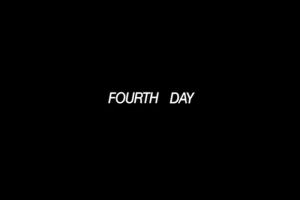
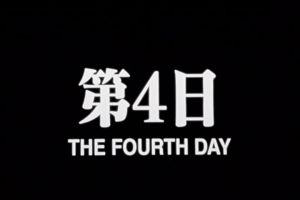
The Beast that Shouted Love at the Heart of the World
The English title of Episode 26, The Beast that Shouted Love at the Heart of the World, comes from a collection of short stories by American author Harlan Ellison[6]. The Japanese word ai (love), could also be interpreted as representing the English "I". Both meanings are appropriate to the episode, but the Harlan Ellison title is considered the correct one.
The Instrumentality of Mankind
The term Instrumentality is taken from Cordwainer Smith's[7] science fiction stories (all of which can be found in the collection Rediscovery of Man).
Interestingly enough, Smith has also written a spy novel named Atomsk[8], which also happens to be the name of a space pirate in another Gainax production, FLCL (a.k.a. Fooly Cooly).
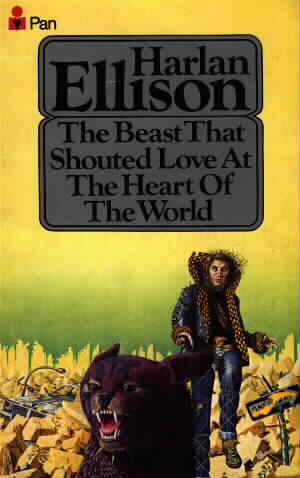
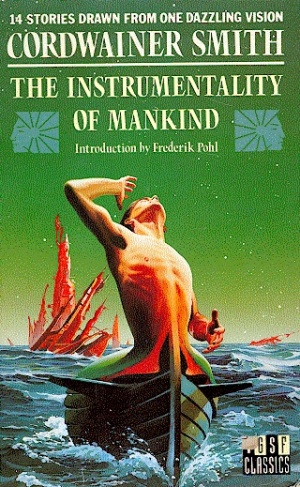
UFO
| Commander Straker and Colonel Freeman | |||
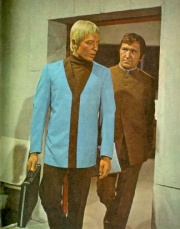 |
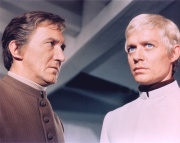 |
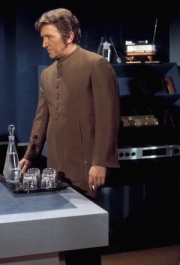 |
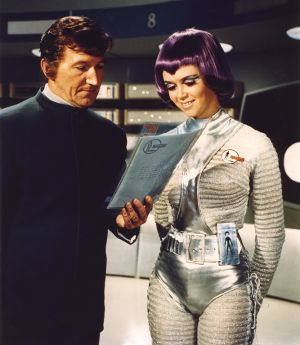 |
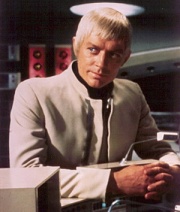 |
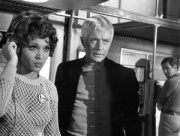 |
[[File:Ufo_commander_straker_3.jpg|thumb|left|180px|Straker no doubt making arrangements for JA's sabotage]] | 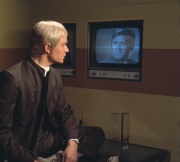 |
Another Gerry Anderson reference: UFO was an early 1970's UK television sci-fi show[9], with UFO being archaically (and now comically) pronounced as "you-foe". According to Evangelion's character designer Yoshiyuki Sadamoto, the characters of Gendo and Fuyutsuki were modeled after UFO's Commander Ed Straker and Colonel Alec Freeman[10].
Straker was the commander of the clandestine Earth defence organisation SHADO, with Freeman as his right hand man. The two were often seen together.
Freeman's suit more obviously resembles Fuyutsuki's, but with buttons instead of a zip. But in fact Freeman at times wears a suit similar to Strikers straight zip suit.
Straker's SHADO zip up suit bears resemblence to Gendo's Nerv Uniform. Straker's uniform usually features a waistcoat, and lacks the themed cuffs of the Nerv uniforms.
The organisation SHADO which Straker commands is a clandestine with an underground HQ disguised beneath a film studio. Much of the show focuses on Straker's running of SHADO, as task which he is utterly devoted to, to the exclusion of his personal life.
Jason Hellwege writes:
"In Ep. ?? where they flash back through the setting up of NERV, there's a
scene where Fuyutsuki confronts Gendou in his office. Fuyutsuki has a briefcase on which he slides his nameplate across to reveal text on a red background reading "DESTRUCT NEGATIVE" on it. He then opens the case.
This is nearly identical to the exploding briefcase of Commander Straker from the Gerry Anderson series "UFO" (1969/70), the only difference being the location of the nameplate on the briefcase.
...I've also noticed that Anno was in his youth a member of an Anime society called "S.H.A.D.O.", SHADO being the military organisation from the series UFO. So it would appear that he should be familiar with the Anderson
universe(s)."
Childhood's End
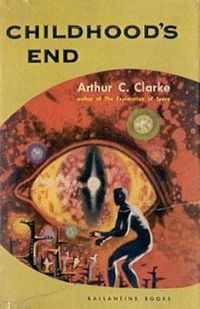
Arthur C. Clarke's novel, Childhood's End, which was published in 1953 features a concept similar to Instrumentality. In Childhood's End, a race of devil-like aliens called the Overlords land on Earth and immediately put a stop to all wars, creating a virtual utopia on Earth. Years pass and children start displaying telephathic abilities. The Overlords reveal that their true purpose for arriving at Earth was to prepare humanity for absorbtion into the Overmind, an entity that exists as a hive-mind of consciousnesses from numerous civilizations. As the novel comes to a close, all adults have died off and the telephathic children, all that is left of humanity is absorbed into the Overmind.
The General Zapped an Angel
The cover of a 1970 edition of Howard Fast's SF anthology The General Zapped an Angel distinctly resembles the appearance of Lilith's head in the final scene of End of Evangelion. According to Wikipedia, 'Fast described the stories as "about the general childishness of man, the only form of life that refuses to grow up."'
Ultraman Ace
The next episode preview of Evangelion 3.0 at the end of the 2nd movie contained a scene with Fuyutsuki facing 4 shadowed figures with a circular pattern on the floor. The symbols actually come from Ultraman Ace, the 5th show in the Ultra series, which features the 5 Ultraman Brothers. Their crosses have the symbols found in the 3.0 preview. The flashback during Evangelion 2.0 of 2nd Impact which features the 4 "Adams" share similarities between the Ultramen as well.
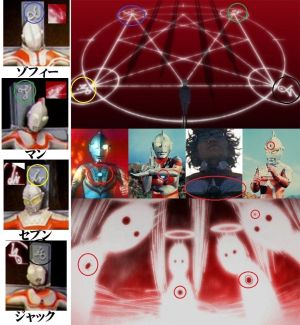
Referanslar
- ↑ "Sadamoto Yoshiyuki ile Röportaj"dan bir alıntı.
- ↑ Youtube video of a famous dogfight scene by Anno and Ichiro "Itano Circus" Itano.
- ↑ Anno interview about Rahxephon
- ↑ http://sciencefictionbiology.blogspot.com/2007/09/farandolae.html
- ↑ http://www.imdb.com/title/tt0066769/
- ↑ http://harlanellison.com/home.htm
- ↑ http://en.wikipedia.org/wiki/Cordwainer_Smith
- ↑ http://www.cordwainer-smith.com/atomsk.htm
- ↑ Detailed UFO Series fansite.
- ↑ http://eva.onegeek.org/pipermail/evangelion/2006-November/003855.html
